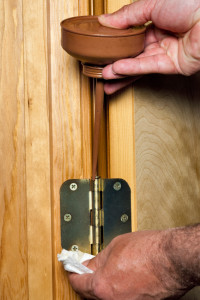When you rent a house in GPS Renting, you may encounter some common maintenance problems, such as Jammed Garbage Disposal, Loose Toilet Seat, or misaligned door. These problems usually only need to be solved within one hour.So GPS Renting launched a DIY series of articles. In our DIY series, we will teach you how to fix some common household problems to reduce repair costs.
Squeaky doors and creaky floors are annoying, but if you’re trying to sell your home, they can actually scare away potential buyers who may wonder what other repairs you’ve failed to make.
There are numerous ways to try to silence these squeaks in your house. Some fixes are quicker and cheaper than others. And, pros warn, it’s unlikely any of these repairs will make the squeaks disappear forever; ongoing maintenance may be necessary to keep the peace – and quiet.
Subdue door squeaks

The cries that come from noisy door hinges are generally due to wear or settling. These squeaks and squeals can be quieted by squirting a few drops of oil into the offending hinge. This repair should stop the creaks for a little while.
If you are in search of long-term quiet, close the door and tap out one hinge pin at a time. Most hinges with removable pins are open at the bottom, so you can gently hammer a nail up, against the hinge pin to push it out far enough to grab it with your fingers or pliers. A bend in the pin could be the source of your squeak; place it on a sturdy surface and tap it straight with a hammer. (If straightening doesn’t work, you can buy replacement hinge pins at most hardware stores – just take along the original to be sure you’re getting the right size).
Once you’re sure the hinge pin is straight, use a piece of super fine steel wool to wipe away clean any dirt, rust or paint, then coat the pin with white lithium grease before tapping it back into place and moving onto the next pin. Once hinges are back in place, open and close the door to distribute the lubricant and wipe away any excess grease.
How to stop the squeak in your floors
Hardwood floors are beautiful, but after years of walking on them, they can become squeaky. Floorboards or subflooring rubbing against each other are generally to blame for the noise.
In order to squelch the sound, you need to know where it’s coming from. Walk around until you’re able to isolate the source of the squeak. The quick, easy fix is to Try sprinkling talcum powder around the offending boards. The powder will work to reduce friction between the boards and might temporarily quiet the squeak.
The long-term repair you choose will depend on where the squeak is in the floor and whether you can access the joists. Here are a few approaches:
- Space between joist and subfloor from below: If you can, go to your basement or crawl space and locate the squeaky spot from below. Your goal is to remove the “give” in the floor; you can accomplish that by tapping a shim coated with carpenter’s glue into the space between the joist and the subfloor. Tap gently so you don’t end up raising the flooring. To add permanence to your repair, you can drive a one-and-a-quarter-inch drywall screw at an angle through the joist and shim and into the subfloor. Some pros also advise squeezing a thick bead of construction adhesive into the crack along both sides of the squeaky joist and subfloor.
- Fix floorboards rubbing from below: If the squeak is caused by floorboards rubbing against each other – not near the joist – you’ll need to screw the subfloor to the wood flooring from below. Drill a pilot hole about a half-inch shorter than the thickness of the subfloor plus flooring and use screws one-quarter-inch shorter than the floor’s total thickness. (Check the thickness by pulling a floor register and measuring the exposed floor.) Space your screws about six inches apart in the area of the squeak.
- Fix from above: If you don’t have access to the underside of your floor, you’ll have to tackle the repair from above, basically by screwing the subfloor to the joists to keep them from moving around. The trick? How to do this without damaging your floor. Long finish nails can be used to pull the floor tight to the underlying joist. If the problem is caused by the floor pulling away from the subfloor, drive two nails into the floor at opposing angles. You’ll want to use a nail set to push the nails below the surface of the floor, then fill the holes with wood filler.
There are several products on the market to help with these repairs. Squeeeeek-No-More, for example, can be used to quiet squeaks on carpet floors laid over wood subfloors. The special screws are designed to break off below the surface of the subfloor so they can do their job without being seen.
Insert the screwhead into the slot, then rock the fixture back and forth until the screw breaks off below the surface. Similarly, the Counter-Snap Kit includes breakaway screws designed to stop squeaks in hardwood; once the repair has been made, you simply fill the hole with wood putty.
GPS Renting is a Seattle property management company. We provide full property management services for homeowners and investors. GPS Renting brings cutting edge mobile technology, professional and extensive real estate experience, and dedicated services to help our landlord have a smooth and worry-free property management experience in Seattle Area.
